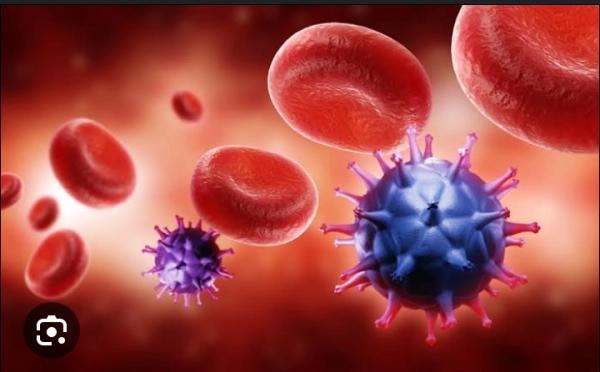Amicable1996
Lab Scientist : I'm A Positive And Resourceful Individual Who Can Execute Difficult Tasks And Doesn't Need To Be Micromanaged. Am A Resolute And Dependable Person With Unwavering Determination To Do Well At My Job And Solve Problems In The Most Autonomous Manner Possible. I Am A Passion Driven Personality With Managerial, Entrepreneurial, Leadership, Communication And Interpersonal Skill.
Wants to meet Laboratory Scientist
Articles
14
Followers
4
Connect with me
profile/6213IMG_20211120_124314_487.jpg.webp
Amicable1996

Infections In Women: Understanding, Preventing, And Managing Health Risks
~2.8 mins read
Introduction:
Infections have long been a significant health concern for women across the globe. From reproductive tract infections to urinary tract infections, women are often more susceptible due to their unique anatomical and hormonal characteristics. This article delves into the various types of infections that affect women, their causes, symptoms, preventive measures, and treatment options.
1. Common Types of Infections in Women:
a. Urinary Tract Infections (UTIs): UTIs are one of the most prevalent infections among women. They occur when bacteria enter the urethra and travel up to the bladder. Symptoms include frequent urination, burning sensation, and lower abdominal pain.
b. Yeast Infections: Caused by an overgrowth of Candida fungus, yeast infections commonly affect the vaginal area. Symptoms include itching, burning, and a thick, white discharge.
c. Bacterial Vaginosis (BV): BV results from an imbalance of bacteria in the vaginal area. It's characterized by a foul-smelling discharge and itching. While not considered a sexually transmitted infection (STI), it can increase the risk of contracting STIs.
d. Sexually Transmitted Infections (STIs): These infections, such as chlamydia, gonorrhea, and herpes, can affect both men and women. However, some STIs can have more severe consequences for women, including infertility and cervical cancer.
2. Causes and Risk Factors:
Several factors contribute to the susceptibility of women to infections:
- Anatomical Factors: The shorter urethra in women makes it easier for bacteria to enter the urinary tract.
- Hormonal Changes: Fluctuations in hormone levels during menstruation, pregnancy, and menopause can alter the vaginal environment and increase infection risk.
- Sexual Activity: Sexual intercourse can introduce bacteria into the urinary tract and vaginal area.
- Hygiene Practices: Incorrect hygiene practices, such as douching, can disrupt the natural balance of bacteria in the vagina.
- Weakened Immune System: Certain medical conditions and medications can weaken the immune system, making women more prone to infections.
3. Prevention Strategies:
a. Hygiene: Maintain proper genital hygiene by using mild soap and water for cleansing. Avoid douching, as it can disturb the vaginal pH and increase infection risk.
b. Urination Habits: Urinate before and after sexual intercourse to help flush out bacteria from the urinary tract.
c. Clothing: Wear breathable cotton underwear and avoid tight-fitting clothing to prevent moisture buildup in the vaginal area.
d. Sexual Health: Practice safe sex using barrier methods like condoms to reduce the risk of STIs. Limit the number of sexual partners to decrease exposure to infections.
e. Diet and Hydration: Staying hydrated and maintaining a balanced diet can support a healthy immune system, aiding in infection prevention.
4. Diagnosis and Treatment:
a. Diagnosis: Healthcare providers use various methods to diagnose infections, including physical exams, lab tests, and cultures of vaginal or urine samples.
b. Treatment: Treatment depends on the type of infection. UTIs are commonly treated with antibiotics, while yeast infections may require antifungal medications. Bacterial vaginosis is typically treated with antibiotics as well.
c. STIs: Early detection and treatment of STIs are crucial. Some STIs can be cured with antibiotics, while others are managed with antiviral medications. Regular STI screening is recommended, especially for sexually active individuals.
5. Seeking Medical Attention:
Women should consult a healthcare provider if they experience symptoms of an infection. Self-diagnosis and self-medication can lead to complications or ineffective treatment.
Conclusion:
Infections in women are a significant health concern, often influenced by anatomical, hormonal, and behavioral factors. Understanding the types of infections, their causes, and preventive measures empowers women to take control of their health. With proper hygiene, safe sexual practices, and timely medical attention, many infections can be prevented or effectively managed, promoting overall well-being and quality of life.
profile/6213IMG_20211120_124314_487.jpg.webp
Amicable1996

Understanding, Treatment, And Research Progress
~4.9 mins read
Introduction:
Cancer, a group of diseases characterized by the uncontrolled growth and spread of abnormal cells in the body, has been a significant focus of medical research and treatment for decades. With its devastating impact on individuals and society, understanding cancer's causes, progression, treatment options, and ongoing research efforts is crucial. This article delves into these aspects, highlighting the latest advancements in cancer research and treatment.
I. Causes and Risk Factors:
Cancer arises due to genetic mutations that disrupt the normal regulatory mechanisms of cell growth and division. While these mutations can occur spontaneously, various risk factors increase the likelihood of their development. These risk factors include tobacco use, unhealthy diet, physical inactivity, exposure to certain chemicals and radiation, as well as genetic predisposition. A deeper understanding of these factors has led to targeted prevention strategies and early detection methods.
II. Progress in Early Detection:
Early detection is a critical factor in improving cancer survival rates. Screening methods like mammograms, Pap tests, and colonoscopies have significantly aided in identifying cancers at an earlier, more treatable stage. Furthermore, advancements in imaging technologies, such as MRI and PET scans, have enhanced our ability to visualize tumors with greater precision, facilitating early intervention.
III. Treatment Approaches:
Cancer treatment has evolved beyond traditional methods like surgery, chemotherapy, and radiation therapy. Targeted therapies focus on specific molecules involved in cancer growth, minimizing damage to healthy cells. Immunotherapy harnesses the body's immune system to recognize and attack cancer cells. Additionally, personalized medicine utilizes genetic information to tailor treatment plans for individual patients, improving treatment efficacy and reducing side effects.
IV. Emerging Technologies:
In recent years, cutting-edge technologies have revolutionized cancer research and treatment. Liquid biopsies, for instance, allow for the detection of tumor DNA fragments circulating in the blood, enabling non-invasive monitoring of cancer progression and treatment response. CRISPR-Cas9 gene editing offers the potential to precisely modify cancer-related genes, opening new avenues for targeted therapy development.
V. Advances in Cancer Research:
The landscape of cancer research is dynamic and ever-evolving. Genomic studies have provided insights into the genetic underpinnings of various cancers, leading to the identification of novel therapeutic targets. The advent of big data and artificial intelligence has enabled researchers to analyze vast amounts of information, uncovering hidden patterns that contribute to cancer development and progression.
VI. Hopeful Trends:
Despite the challenges posed by cancer, there are promising trends on the horizon. The development of combination therapies, which combine different treatment modalities, has shown remarkable success in tackling treatment-resistant cancers. Moreover, breakthroughs in understanding the tumor microenvironment have shed light on how cancer cells interact with their surroundings, paving the way for innovative treatment strategies.
VII. Supportive Care and Survivorship:
Cancer treatment often comes with physical, emotional, and psychological challenges. Supportive care programs have been established to provide patients with comprehensive care beyond medical treatment, addressing their holistic needs. Furthermore, as survivorship rates improve, survivorship programs help individuals navigate life after cancer, focusing on physical and emotional well-being.
Certainly, let's delve deeper into the various aspects of cancer treatment:
Traditional Treatment Modalities:
1. Surgery: Surgical removal of tumors is a primary treatment for many types of cancer. It aims to physically eliminate cancerous tissue from the body. Advances in minimally invasive techniques, such as laparoscopy and robotic surgery, have led to shorter recovery times and reduced complications.
2. Chemotherapy: Chemotherapy involves using drugs to destroy or inhibit the growth of cancer cells. It is commonly used for cancers that have spread throughout the body. However, it can also affect healthy cells, leading to side effects such as nausea, hair loss, and fatigue.
3. Radiation Therapy: This treatment uses high-energy rays to target and kill cancer cells. It can be delivered externally using machines or internally through implants. Precise radiation delivery techniques like intensity-modulated radiation therapy (IMRT) and proton therapy minimize damage to surrounding tissues.
II. Targeted Therapies:
Targeted therapies are designed to block specific molecules or pathways involved in cancer growth and progression. By focusing on these specific targets, these therapies are often more effective and cause fewer side effects compared to traditional treatments. Examples include monoclonal antibodies and small molecule inhibitors.
III. Immunotherapy:
Immunotherapy harnesses the power of the immune system to recognize and attack cancer cells. Checkpoint inhibitors, such as PD-1 and CTLA-4 inhibitors, prevent cancer cells from evading immune detection. Adoptive T cell therapy involves engineering a patient's own T cells to target cancer cells, yielding remarkable results in some cases.
IV. Hormone Therapy:
Hormone therapy is used for cancers that are hormone-sensitive, such as certain types of breast and prostate cancer. It involves blocking or manipulating hormones to inhibit cancer growth. This approach can be particularly effective in slowing down the progression of hormone-driven cancers.
V. Personalized Medicine:
Advancements in genomics have paved the way for personalized cancer treatment. Genetic testing of tumors helps identify specific mutations or alterations, allowing oncologists to tailor treatment plans based on a patient's genetic profile. This approach improves treatment efficacy and reduces unnecessary side effects.
VI. Combination Therapies:
Combining different treatment modalities has become a common approach to tackling cancer. Combinations of surgery, chemotherapy, radiation therapy, targeted therapies, and immunotherapies are often used to address multiple aspects of cancer growth and metastasis, increasing the chances of successful treatment outcomes.
VII. Supportive Care:
Supportive care plays a vital role in cancer treatment by managing side effects, enhancing quality of life, and providing emotional and psychological support. Palliative care focuses on symptom management and improving patients' comfort, while hospice care provides comprehensive end-of-life care for individuals with advanced cancer.
VIII. Clinical Trials:
Clinical trials are essential for advancing cancer treatment options. They test new therapies, treatment combinations, and approaches to ensure their safety and efficacy. Participating in clinical trials gives patients access to cutting-edge treatments that may not be available through standard care.
IX. Challenges and Future Directions:
Despite the progress made in cancer treatment, challenges remain. Resistance to therapies, treatment-related toxicity, and high treatment costs continue to pose obstacles. However, ongoing research into novel treatment strategies, as well as the integration of AI and big data analysis, holds promise for overcoming these challenges and improving patient outcomes.
Conclusion:
The fight against cancer is a complex and ongoing battle, marked by continuous advancements in understanding, detection, and treatment. As research continues to unravel the intricacies of cancer biology, new treatment strategies are emerging, offering hope for better outcomes and improved quality of life for those affected by this disease. By staying informed and supporting ongoing research efforts, individuals and society can contribute to the collective endeavor to conquer cancer once and for all.
Advertisement

Link socials
Matches
Loading...
